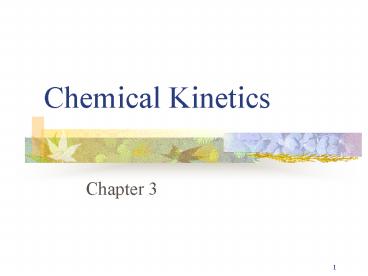Chemical Kinetics - PowerPoint PPT Presentation
1 / 21
Title:
Chemical Kinetics
Description:
Law of constant proportions - compounds made up of same elemental ... Metathesis - rearrangement of atoms, ions: precipitation, softening. 4. Chemical Equations ... – PowerPoint PPT presentation
Number of Views:52
Avg rating:3.0/5.0
Title: Chemical Kinetics
1
Chemical Kinetics
- Chapter 3
2
Chemical Reactions
- Elements combine to form compounds by chemical
reaction (atomic shuffle or rearrangement),
follow - Law of conservation of mass
- Law of constant proportions - compounds made up
of same elemental components in same proportion
by weight - Law of multiple proportions - ratios of wt of 1
element combining with fixed amt of another is in
small whole nos.
3
Types of Chemical Reactions
- Proton transfers (acid base reactions)
neutralization, alkalinity measurements - Electron transfer (oxidation/reduction)
chlorination, ozonation, biological treatment - Electron sharing (covalent, ionic bonding) ion
exchange, precipitation, softening - Metathesis - rearrangement of atoms, ions
precipitation, softening
4
Chemical Equations
- Used to describe chemical reactions
- aA bB-----gt cC dD
- products reactants
- Balanced equation (including redox reactions)
- Reaction quantities
5
Chemical Kinetics
- Approaches in evaluating a chemicals fate and
treatment kinetics and equilibrium - Kinetics deals with the rates of reactions.
- Kinetic approach is appropriate when the reaction
is slow relative to our time frame or when we are
interested in the rate of change of
concentration. - Rate Change in concentration/time
6
Factors that affect reaction rate
- Concentration of reactants
- Increasing concentration of reactants often
increase the rate of reaction - Temperature
- Increasing the temperature generally increases
the rate of reaction - Catalysts
- Catalysts increase the rate of reaction without
themselves being consumed
7
The Rate Law
- Rate law used to predict the rates of chemical
and biological processes. - The rate law describes the relationship between
the rate of a reaction and the concentration of
the reactants.
8
Reaction Rate
- Rate (R ) kAaBb
- The rate constant, k
- Relates rate and concentration at a particular
temperature
9
The reaction order
- The rate law describing the decrease in
concentration of chemical C with time
where C is concentration of C t is time k is
rate constant dependant on the order of the
reaction n, reaction order
10
Zero-order Reaction
- If n is zero,
- This is the rate law describing a zero-order
reaction.
Unit conc/time (moles/L-s)
11
First-Order Reaction
- If n1,
- This is the rate law for a first-order reaction.
- E.g. radioactive decay.
(Unit of time-1,e.g. s-1)
12
Example 13
- How long will it take the CO concentration in a
room to decrease 99 after the source of CO is
removed and the windows are opened? Assumed the
first-order rate constant for CO removal (due to
dilution by incoming clean air) is 1.2 h-1.
13
Pseudo-First-Order Reactions
- The rate law for this reaction is
- If the concentration of A does not change
significantly during the reaction i.e. - , the
concentration of A may be assumed to be
constant can be incorporated into the rate
constant, k.
14
- Then, the rate law becomes
- where k is the pseudo-first-order rate constant
and equals kA0a. - The rate law for disappearance of substance B
- If b1,
15
Example 14
- An engineer is modeling the transport of a
chemical contaminant in groundwater. The
individual has a mathematical model that only
accepts first-order degradation rate constants
and a handbook of "subsurface chemical
transformation half- lives." Subsurface
half-lives for benzene, TCE, and toluene are
listed as 69, 231, and 12 days, respectively.
What are the first-order rate constants for all
three chemicals?
16
Half-life
- The half-life, t½, is defined as the time
required for the concentration of a chemical to
decrease by one half (e.g. C0.5C0. - For zero-order reactions 0.5C0 C0-kt½
- For first-order reactions 0.5C0 C0e-kt
17
Example 15
- After the Chernobyl nuclear accident, the
concentration of 137Cs in milk was proportional
to the concentration of 137Cs in the grass that
cows consumed. The concentration in the grass
was, in turn, proportional to the concentration
in the soil. Assume that the only reaction by
which 137Cs was lost from the soil was through
radioactive decay and the half-life for this
isotope is 30 years. Calculate the concentration
of 137Cs in cow's milk after 5 years if the
concentration in milk shortly after the accident
was 12,000 Bq/L. (Note A Bequerel is a measure
of radioactivity. One Bequerel equals one
radioactive disintegration per second.)
18
Effect of Temperature on Rate Constant
- Rate of molecular motion was a function of
temperature. - Higher the temperature, the faster the molecules
move, which results in an increase in the number
of collisions per unit time. A higher temp. also
increases the energy of the collisions. - As a result, a greater fraction of the collisions
results in a chemical reaction. - Thus, the rate of chemical reactions that depend
on collision of two or more molecules will be
increased by an increase in temperature.
19
Arrhenius equation
- The Arrhenius equation is used to adjust rate
constants for changes in temperature - where k is the rate constant of a particular
order - A is termed as preexponential factor (same unit
as k) - Ea is the activation energy (kJ/mole)
- R is the gas constant
- T is a temperature (K)
20
Rate Constant for CBOD
- The carbonaceous biochemical oxygen demand (CBOD)
rate constant, kL, known at a particular
temperature, is typically converted to other
temperatures using the following expression - is a dimensionless temperature coefficient.
- In fact, equals
21
Example 16
- The rate constant for CBOD at 20oC is 0.1 day-1.
What is the rate constant at 30oC? Assume
1.072.































